Police vehicles in the United States and Canada
Police vehicles in the United States and Canada consist of a wide range of police vehicles used by police and law enforcement officials in the United States and in Canada. Most police vehicles in the U.S. and Canada are produced by American automakers, primarily the Big Three, and many vehicle models and fleet norms have been shared by police in both countries.
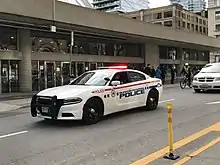
A majority of officially-marketed American and Canadian police vehicles—as in those officially marketed as such by their manufacturer—are classified as pursuit packages, which generally denote vehicle models that are capable of handling a majority of police tasks, primarily regular patrol duties but also, as the name implies, pursuits. Other models are often classified as special service packages, which generally denote specialized vehicles designed to fulfill specific tasks or utility roles, such as transport vans, pickup trucks, SWAT vehicles, and performance cars. Combined, these police fleet offerings are often referred to by manufacturers as police packages.
Unlike many other countries, American and Canadian law enforcement agencies are generally not limited by regulations on vehicle models or livery marking designs, meaning that, while there may be varying regulations on emergency vehicle equipment or unmarked police vehicles in each jurisdiction, there is no standardized vehicle livery design, and most agencies have their own unique designs.
History
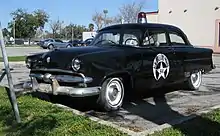
The first police car in the world was an electrically-powered wagon, operated by the Akron Police Department in 1899. The $2,400 vehicle was equipped with electric lights, gongs, and a stretcher, and could reach 16 mph (26 km/h) and travel 30 mi (48 km) before its battery needed to be recharged. The car's first assignment was to pick up a drunken man at the junction of Main and Exchange streets.[1][2] Since the 1920s, the New York City Police Department has used vehicles for patrol duties, referred to as "Radio Motor Patrol" vehicles.[3]
Ford's introduction of the flathead V-8 in its Model 18 in 1932—the first low-priced, mass-marketed car with a V8 engine—proved popular amongst police departments and led to strong brand loyalty. In turn, this gave the company a market-capturing edge that lasted until 1968. In the 1940s and 1950s, the "Big Three" (Ford, General Motors, and Chrysler) began to offer specialized police packages with severe duty parts. Foremost amongst these was the Ford package of 1950, which utilized the larger and more powerful Mercury engine in the smaller, lighter Ford. This ended the practice of some state police forces buying larger and more powerful, but higher-priced models including Buicks, Hudsons, and Chryslers. In 1969, Plymouth took first place in the police market, with Chrysler's 440 cu. in. V8s, Torqueflite transmissions, and torsion bar suspensions giving them a compelling advantage. Chrysler held this lead until the 1970s energy crisis drove buyers to smaller cars, and Chrysler subsequently discontinued their rear-drive platform after the 1989 model year.[4]
Police have historically used full-size, low-expense sedans since the days of the Ford Model A, though many police departments switched to intermediates—such as the Plymouth Satellite, Ford Torino, and AMC Matador—in the 1960s and 1970s. Some state police forces adopted pony cars, such as the Ford Mustang, Chevrolet Camaro, and AMC Javelin, for use as pursuit vehicles. The Ford LTD, Plymouth Gran Fury, and Chevrolet Caprice were re-adopted as standard when the models were downsized in the late 1970s.
After the discontinuation of the Chevrolet Caprice in 1996, the Ford Crown Victoria Police Interceptor replaced it, becoming iconic as a police car due to its prevalence in fleets across North America. Other models such as the Chevrolet Impala (8th and 9th generations), Chevrolet Tahoe, and Dodge Charger also gained a percentage of the market during this period, and were often bought to diversify fleets and minimize disruption in the event of a Ford recall.[5]
Following the discontinuation of the Crown Victoria, Ford replaced their fleet offerings with police versions of the Ford Taurus and Ford Explorer, which remained popular with fleets.[6] General Motors marketed a revived Chevrolet Caprice as a fleet-only vehicle alongside a fleet-only 9th-generation Impala, while Dodge continued marketing their Charger, which was viewed as a viable sedan replacement for the Crown Victoria.[7][8]
With the discontinuation of the Taurus, Impala, and Caprice, the police fleet market as of 2022 is dominated by crossovers and SUVs, with the Ford Explorer, Chevrolet Tahoe, and Dodge Durango predominantly marketed alongside similar models.[9] The only sedan currently marketed for police fleets is the Dodge Charger,[10] which is expected to be discontinued in 2023.[11]
Common vehicles
Subject to federal, state, provincial and local laws, any vehicle, appropriately modified, can be used as a police vehicle, but the most common are those designed or modified by manufacturers as police or special service vehicles. Though previously dominated by sedans, sport utility vehicles and crossovers have become increasingly popular in police fleets, reflecting wider vehicle market trends. Benefits often cited include extra room for equipment and better outward visibility due to the higher seating position compared to sedans.[12]
The following model year 2020 and 2021 vehicles (in various drivetrain configurations) were submitted by manufacturers for the 2021 evaluation by the Michigan State Police:[13]
- 2021 Chevrolet Tahoe PPV (RWD and 4WD)
- 2021 Dodge Charger Pursuit (AWD and RWD)
- 2021 Dodge Durango Pursuit
- 2020 Ford Police Interceptor Utility (based on the 2020 Ford Explorer)[14]
- 2021 Ford F-150 Police Responder
Other police fleet vehicles available from the same manufacturers during those model years include the Ford Expedition, Chevrolet Suburban, Chevrolet Silverado, Chevrolet Express, Ford Transit, and Ram 1500. Older models, namely the Ford Crown Victoria, Chevrolet Impala, Chevrolet Caprice, and Ford Police Interceptor Sedan, retain their popularity in fleets, but are gradually being phased out due to maintenance costs, mileage, and their end of production.
Common SWAT vehicles include the Lenco BearCat, BAE Caiman, and other armored vehicles of similar configurations.
Common motorcycles include the Harley-Davidson FLTHP and BMW R1200RT-P.
Other vehicles
%252C_front_NYIAS_2022.jpg.webp)
Other vehicles are used in varying capacities by some agencies, such as the Toyota Prius,[15] Smart Fortwo,[16] BMW i3,[17] and other models that are not officially sold to fleets.
Electric vehicles have gradually become more prevalent in police fleets as electric vehicles become increasingly popular. In 2017, when Fremont Police Department purchased a Tesla Model S for patrol duty, making it the first Tesla police car in the world;[18] since then, electric vehicles have been added to police fleets in Boulder City,[19] Dearborn,[19] Hallandale Beach,[20] and New York City,[21] among other departments. The first Tesla police car in Canada was purchased by the Bridgewater Police Service in 2022;[22][23] later that year, the Royal Canadian Mounted Police announced they would be acquiring a Tesla Model Y, their first electric police car, in 2023.[24]
Classic police cars may also remain in service, often out of heritage or community appeal; these vehicles are often only used at events or parades, and are not used in frontline patrol duty. However, this is not always the case; for example, the McHenry County Sheriff's Department operates a retrofitted 1995 Chevrolet Caprice for regular patrol duties as of 2016.[25] As of 2023, new EV patrol cars such as the Chevy Blazer PPV and F-150 Lightning SSV come to service.[26][27]
D.A.R.E. cars
.jpg.webp)
A number of Drug Abuse Resistance Education (D.A.R.E.) programs in American police departments have vehicles marked as police cars to promote the program. These "D.A.R.E. cars" are vehicles that have been seized from drug dealers and converted into a police vehicle. They are used to send the message that drug dealers forfeit all their glamorous trappings when they get caught. Traditionally, these vehicles are expensive, luxury, or performance cars, though more recent examples are simply police fleet vehicles with D.A.R.E. liveries.[28]
Response cars
U.S. response cars are usually seized due to their high price and unnecessariness.[29] [30] [31] Police response units are usually Chevrolet Camaro SS, Dodge Challenger R/Ts, Ford Mustang GTs. These cars are used for pursuing and being stealthy for unexpecting dangerous drivers.[32][33][34] But for extremely high performance cars like Dodge Challenger and Charger Hellcats are seized.[35][36] Some famous response cars like the LAPD's donated Lamborghini Gallardo,[37][38][39] Texas Department of Public Safety's seized 1080 horsepower Dodge Challenger SRT Hellcat Redeye,[40][41] New Braunfels Police Department's seized 1005 horsepower Chevrolet Corvette C6 Z06,[42][43][44][45] West Bloomfield Police Department's Ferrari F8 Tributo[46][47] and Steve Saleen's gifted Saleen Mustang S302s to police forces Riverside and Seal Beach Police Departments. [48][49] In Canada, the Ontario Police Department do have a Chevy Corvette C8 Z06.[50][51]
Not all of these cars are intend to be in service. New Braunfels seized Corvette C6 Z06 is only for events and charities.[52] This Corvette was seized in a drug bust with racing modifications up to $80k. LAPD's Lamborghini Gallardo is donated by a couple Nathalie & Travis Marg for their use of their car. It's use for also charity. West Bloomfield's Ferrari F8 was gave by a Ferrari dealer and also a 488 Pista gave to the fire department. The Ferrari F8 will not be in service in traffic duty. The two Ferraris is for public viewing.
In Canada, Ontario PD's Corvette C8 Z06 is use for promotion for officers to be recruited.
The Texas Department of Public Safety Challenger Hellcat Redeye is currently in service for traffic duty. As well as another seized 2015 Challenger Hellcat in Marion County Sheriff in Florida is also in service. Several police departments use Dodge Challenger and Charger Scat Packs and Hellcats across the U.S.[53][54][55][56][57]
Steve Saleen gave Saleen Mustang S302s to Police Departments for the fallen officers who was in service. These high powered Saleen Mustangs can reach 0-60 mph in 3.2 seconds and their engines pushing over 700 horsepower. Which makes these cars the fastest U.S. police cars in the country which is actively in service.
Appearance
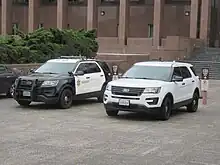
In the United States and Canada, the livery design for each fleet is usually determined by each individual agency; only Minnesota[58] and Ohio[59] have legislation specifying what police vehicle liveries must look like. Usually, laws exist that establish standards for police vehicle markings, and proscribe civilian vehicles from using certain markings or paint schemes, as is the case in California.[60]
Livery designs vary by jurisdiction. The side doors, hood, or trunk of a marked police car usually bear the seal or badge of the agency, city, or county, often in reflective finish. Markings such as emergency phone numbers, department mottoes, or website URLs are also common. Some agencies have identification numbers printed on the roofs of patrol cars for tracking of aircraft, or to distinguish specialized units, such as K-9 units or supervisors.
Emergency vehicle equipment, such as emergency lights, pushbars, spotlights, seat partitions, window bars, and hubcaps, vary with each department or service, and may be inconsistent depending on the cruiser's model, purpose, and time of commissioning. North American police cars are historically associated with being painted black and white—specifically, with the doors and roof painted white and the rest of the body painted black. Older police vehicles typically came from the factory painted in a single color, most often white or black. The contrasting black-and-white paint scheme was used to make police vehicles easily stand out from civilian vehicles without requiring bright paint colors, custom designs, graphics, or larger markings. The association between North American police and black-and-white color schemes is so strong that the United States Department of Homeland Security recommends, but does not require, that local law enforcement agencies adopt a black-and-white vehicle color scheme for ease of visual identification nationwide.[61]

Unlike other countries, Battenburg markings are very rare on emergency vehicles in the United States and Canada. However, this does not mean they are completely nonexistent in North America; a few regional police services in Ontario, namely those in St. Thomas, Barrie and Cobourg[62], have adopted yellow and blue Battenburg marking designs on some newer cruisers[63][64][65], although this practice is uncommon in the two countries.
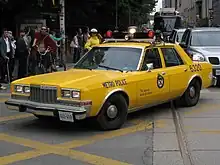
While black and white designs are used in many jurisdictions, many modern police cars use solid colors, primarily neutral tones such as white, black, and grey, often out of budgetary concerns; for example, the NYPD switched from baby blue to white in the late 1990s to save money on painting costs.[66] Other colors, such as shades of blue, green, brown, tan, and red, are used by other agencies. In Canada, yellow was a common color used by municipal and regional police in Ontario until the 1980s; like the NYPD, most police services switched to white paint to save money.[67][68]
Today, most fleet markings on patrol vehicles are created from reflective vinyl with an adhesive backing that is applied in a peel-and-stick manner. Colors chosen to represent the agency's identity are typically chosen by the individual department, although, as noted above, some states have specific guidelines for color schemes and markings. Vinyl used to produce fleets markings comes in large rolls that are fed through a plotter (cutter) or large-format printer/cutter. The designs are created in specialized computer software and sent to the machines via a cable link for production. Once the design is cut into the vinyl, the excess vinyl on the sheet is removed in a process called "weeding". Finally, a paper pre-mask is applied to the top of the vinyl design to allow easy application of multiple letters and shapes at one time.
Unmarked cars and ghost cars

Unmarked police vehicles are common in most agencies in the United States and Canada. Most unmarked police cars are often the same models as marked fleet vehicles, and may be virtually identical to them aside from the lack of roof-mounted emergency lights; however, this depends on the agency, and some may use common civilian vehicle models to blend in with traffic.[69][70]
Many agencies also use "ghost cars" or "stealth cars", which are similar to unmarked cars, but have reflective graphics that are difficult to see unless illuminated by lights or viewed at certain angles.[71][72][73] Ghost cars are often used for traffic enforcement, though they may also be used in jurisdictions where traditional unmarked cars are prohibited or have their enforcement capabilities limited, such as being unable to conduct traffic stops.[70][71]
Unmarked cars and ghost cars are controversial. Proponents argue they help deter illegal driving and keep undercover officers safe from detection,[72] while detractors argue they unfairly focus on issuing tickets and make police less visible on patrol.[71][74] There are also concerns that the existence of unmarked cars enables police impersonators due to the ease in copying an unmarked car as opposed to a marked car.[75]
See also
References
- "City of Akron: News Releases 2009: STATE OF THE CITY PRESENTATION". Archived from the original on March 7, 2009. Retrieved April 3, 2009.
- "The Police Wagon", Akron Beacon Journal, 1999-06-20
- "New York Police Vehicles Through the Ages". The New York Times. December 2, 2016. ISSN 0362-4331. Retrieved September 26, 2022.
- Sanow, Edwin J. (January 16, 1998). Ford Police Cars, 1932–1997. MBI Publishing Company LLC. p. 7. ISBN 0-7603-0372-X.
- Baker, Al (August 21, 2006). "A Police Car With Plenty of Muscle". The New York Times.
- Ziegler, Chris (October 13, 2015). "It's official: for police, the Ford Taurus and Explorer are the new Crown Vic". The Verge. Retrieved September 26, 2022.
- Elbow, Steven (January 14, 2010). "Cops shop for new cars after Ford stops making Crown Victoria". The Cap Times. Retrieved September 27, 2022.
- Anderson, Greg (April 14, 2010). "5 New High-Performance Cop Cars". Popular Mechanics. Retrieved September 26, 2022.
- Alaniz, Anthony. "America's Police Fleet: Every New Cop Car You'll See In The U.S." Motor1.com. Retrieved September 26, 2022.
- Griffith, David (June 16, 2021). "Dodge Charger: The Last Patrol Sedan". www.policemag.com. Retrieved September 26, 2022.
- Gregg, Aaron; Shaban, Hamza (August 16, 2022). "Dodge will retire Charger and Challenger, its muscle car mainstays". Washington Post. ISSN 0190-8286. Retrieved September 26, 2022.
- Woodyard, Chris. "Nation's most popular police car is now an SUV". USA TODAY.
- "Police Vehicle Evaluation: Model Year 2021" (PDF). Michigan.gov. Retrieved July 23, 2021.
- "2020 Ford Police Interceptor Utility Hybrid AWD Saves Fuel, Hauls Ass". Car and Driver. May 17, 2019. Retrieved August 21, 2020.
- "NYPD Prius Cruiser Filmed Repeatedly Ramming Cars In Queens NYC". Carscoops. April 1, 2019. Retrieved September 26, 2022.
- "NYPD's "kissable and huggable" Smart cars receive flood of attention". www.cbsnews.com. June 27, 2017. Retrieved September 26, 2022.
- Lee, Kristen. "The Los Angeles Police Department's barely used BMW i3 EVs keep flying off of used-car lots". Business Insider. Retrieved September 26, 2022.
- Ortiz, Aimee (October 3, 2019). "A Police Tesla Nearly Ran Out of Power During a Chase. It Wasn't the Car's Fault". The New York Times. ISSN 0362-4331. Retrieved September 26, 2022.
- Wilcox, Kyle (September 1, 2022). "Boulder City Police going electric with new Tesla patrol cars". KSNV. Retrieved September 26, 2022.
- Boul, Kevin; Ier • • (July 16, 2022). "It's Electric! Hallandale Beach Police Rolls Out Electric Vehicle Fleet". NBC 6 South Florida. Retrieved September 26, 2022.
- "NYPD shifting to SUVs and electric vehicles as traditional 'interceptor' sedans are gradually retired". New York Daily News. September 18, 2022. Retrieved September 26, 2022.
- "Bridgewater police adding a Tesla to its fleet, first electric patrol car in Atlantic Canada - Halifax | Globalnews.ca". Global News. Retrieved September 26, 2022.
- "LighthouseNow: Bridgewater's first electric police vehicle goes into service". lighthousenow.ca. Retrieved September 26, 2022.
- "Langford gets Island's first Tesla centre, RCMP's first EV cruiser". Nanaimo News Bulletin. March 3, 2022. Retrieved September 26, 2022.
- "20-year-old Chevrolet Caprice still patrolling for McHenry County Sheriff's Office (with video)". Shaw Local. January 26, 2016. Retrieved September 26, 2022.
- "EVs are Taking Over! Meet the Electric Police Cars of Today". May 18, 2023.
- "America's Police Fleet: Every New Cop Car You'll See in the US".
- "2022 Car Show Entries | D.A.R.E. America". Retrieved September 26, 2022.
- "Georgia Sheriff in Hot Water with Dodge Charger Hellcat Purchase".
- "More Florida agencies using unmarked sports cars to catch unsuspecting speeders". February 9, 2023.
- "Muscle Cars Used as Police Vehicles". July 22, 2019.
- "Stealthy Challenger and Mustang Vehicles to Join ADPS Patrol Fleet | Arizona Department of Public Safety".
- "Texas Police Use Chevy Camaro 'Ghost' Cop Cars to Catch Bad Drivers". June 11, 2021.
- "This Ford Mustang SSP Cop Car Remake is More Than Just a Sticker Pack". November 11, 2021.
- "Confiscated Dodge Challenger SRT Hellcat Converted into Police Car by Florida Sheriff's Department". March 24, 2021.
- "Dodge Charger Hellcat seized in drug arrest to be used by sheriff's office". December 9, 2020.
- "LAPD adds Lamborghini Gallardo to Police Fleet". March 19, 2014.
- "LAPD Reveals Lamborghini Gallardo Police Car - Motor Trend WOT". March 18, 2014.
- "LAPD Adds Lamborghini Gallardo to Its Fleet". March 17, 2014.
- Anderson, Brad (October 2, 2022). "Street Racer's Seized 1080 HP Dodge Challenger SRT Hellcat Redeye Is Now Serving Texas Police". Carscoops.
- "This 1,080 HP Dodge Challenger SRT Hellcat Went from Street-Racer to State Trooper". October 2022.
- "New Braunfels Police Department adds Corvette to fleet". September 24, 2015.
- "This 1005-hp Corvette Cop Car Has an Unusual Backstory". May 30, 2017.
- "Texas' New Braunfels Police Department Dubs C6 Corvette Z06 'Coptimus Prime' | GM Authority".
- "New Braunfels Texas Police Department Adds a Corvette Z06 to Fleet". May 31, 2017.
- "Cauley Ferrari Dedicates Two Ferraris to West Bloomfield's First Responders".
- "Dealership stripes Ferrari to look like West Bloomfield police car".
- "Saleen Automotive Delivers 730Hp Police Vehicle". May 10, 2017.
- "Seal Beach Police Department To Get Saleen S302 Police Mustang | Carscoops".
- "OPP Corvette Z06 Isn't A Police Car".
- "[VIDEO] Speeders in Ontario, Beware! There's a New Sheriff in Town". February 14, 2023.
- "New Braunfels Police Department - NAME THE CORVETTE CONTEST The newest addition to the New Braunfels Police Department's fleet, a 2007 Chevrolet Corvette Z06 (which was seized from a drug dealer), will be making its official debut in the Comal County Fair Parade on Sept. 25th. But first, it needs a name! Therefore, NBPD is introducing the…NAME THE CORVETTE CONTEST! PARENTS: Get with your kids (ages 8 to 16) and come up with a family-friendly name for the car. Post your name suggestions here on Facebook by 5pm on Friday Sept. 18th. A committee of Police Department employees will then vote on the submissions and the winner will be announced on Tuesday Sept. 22nd. The winner will not only get bragging rights, but will also win the opportunity to ride inside the Corvette during the Comal County Fair Parade and have their picture taken with the vehicle (plus a few other police department prizes). RULES: Age limit for winning entry: Children ages 8 to 16 years old You may post name suggestions as many times as you wish, but there's only 1 passenger seat in the Corvette, so only one child will be able to win the prize. Any name suggestions that are not family friendly will be promptly deleted and not considered for the prize. All decisions made by the Police Department are final and not subject to review. | Facebook". www.facebook.com.
- "Facebook". www.facebook.com.
- "392 Scat Pack K-9 unit in Georgia". April 16, 2022.
- "Devil Dog in a Hellcat. #LakeCountySheriff | By Lake County K9 Association | Facebook". www.facebook.com.
- "Lake County Sheriff's Department, Indiana Dodge Charger Hellcat". February 9, 2023.
- "Dodge Challenger Scat Pack Cruise | Dodge Challenger Scat Pack Cruise | By Nacogdoches Fleet Specialists | Facebook". www.facebook.com.
- "169.98 - 2006 Minnesota Statutes". www.revisor.leg.state.mn.us.
- "311-3 - 2019 Ohio Administrative Code". codes.ohio.gov.
- Vehicles, California Department of Motor. "Detail". www.dmv.ca.gov.
- "Speeders beware: More cop cars getting the 'panda' paint scheme across North America". thestar.com. May 6, 2016. Retrieved August 21, 2020.
- "Cobourg Police Service test Battenburg-patterned cruiser to increase visibility | Cobourg Police Services". Retrieved October 26, 2023.
- "St. Thomas police testing out new cruiser paint design". London. June 4, 2021. Retrieved March 26, 2022.
- Mays, Jennett (July 26, 2022). "Barrie Police test Battenburg-patterned cruisers to increase visibility | Barrie Police". Barrie Police. Retrieved July 28, 2022.
- Draper, John (August 30, 2023). "Highly Visible Police Cars – Cobourg News Blog". Cobourg News Blog. Retrieved October 26, 2023.
- Krauss, Clifford (June 25, 1996). "New Color Scheme, Mostly White, to Reduce the Cost of Painting Police Cars". The New York Times. ISSN 0362-4331. Retrieved September 26, 2022.
- "Yellow's fading appeal | Maclean's | OCTOBER 13, 1986". Maclean's | The Complete Archive. Retrieved September 26, 2022.
- "Historical photos: Hamilton police drove bright yellow police cars". The Hamilton Spectator. April 1, 2019. ISSN 1189-9417. Retrieved September 26, 2022.
- "How to Spot Undercover Cops and Unmarked Police Cars". Lifehacker. January 5, 2022. Retrieved September 26, 2022.
- "'Ghost' Police Cars Are Becoming More Popular | GetJerry.com". getjerry.com. Retrieved September 26, 2022.
- Day, Lewin (June 10, 2021). "Texas Police Are Now Using 'Ghost' Camaros to Patrol the Highways". The Drive. Retrieved September 26, 2022.
- Wong, Clayton (September 20, 2017). "'Ghost' Cars Lower Crash Rates". www.government-fleet.com. Retrieved August 21, 2020.
- "Emergency Vehicle Visibility and Conspicuity Study" (PDF). p. 24. Retrieved January 25, 2014.
For law enforcement vehicles, retroreflective material can be concentrated on the sides and rear to maintain stealth when facing traffic or patrolling.
- Latu, Dan (March 27, 2022). "'Aren't we supposed to be able to see them easily?': TikToker shows 'ghost' cop car, sparking debate". The Daily Dot. Retrieved September 26, 2022.
- Freind, Christopher (May 21, 2012). "Unmarked Police Cars Lead to Dangers for Citizens | The Philly Post". Philadelphia Magazine. Retrieved September 27, 2022.
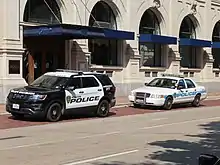
.svg.png.webp)